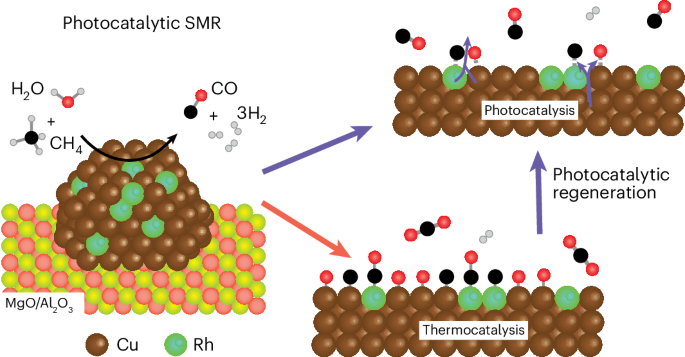使用可再生天线反应器等离子光催化剂进行蒸汽甲烷转化
IF 42.8
1区 化学
Q1 CHEMISTRY, PHYSICAL
引用次数: 0
摘要
蒸汽甲烷重整(SMR)是制氢的主要工业流程。目前,它依赖于高温操作条件,并与高碳强度相关。光催化 SMR 可以提供更环保、更高效的氢气生产。在此,我们展示了一种基于 Cu-Rh 天线反应器光催化剂的等离子体光催化方法,由于等离子体介导的热载流子贡献,这种光催化方法可实现高活性、高选择性和高稳定性的 SMR。我们观察到,这种光催化剂在光催化过程中本质上是稳定的,但在热催化过程中会失活;不过,热失活的催化剂可以通过共振照明再生。对再生机制进行了详细研究,发现它是由等离子体诱导的氧和碳物种的关联解吸引起的。本文章由计算机程序翻译,如有差异,请以英文原文为准。


Steam methane reforming using a regenerable antenna–reactor plasmonic photocatalyst
Steam methane reforming (SMR) is the major industrial process for hydrogen production. It currently relies on high-temperature operating conditions and is associated with high carbon intensity. Photocatalytic SMR could provide greener and potentially more efficient H2 production. Here we demonstrate a plasmonic photocatalytic approach based on a Cu–Rh antenna–reactor photocatalyst for highly reactive, selective and stable SMR due to plasmon-mediated hot carrier contributions. We observe that the photocatalyst is intrinsically stable in photocatalysis but deactivates under thermocatalysis; however, the thermally deactivated catalyst can be regenerated by resonant illumination. The regeneration mechanism is studied in detail and found to be caused by plasmon-induced associative desorption of oxygen and carbon species. Catalysts used for steam methane reforming frequently suffer from deactivation by coking and oxidation. Here an active Cu–Rh plasmonic antenna–reactor photocatalyst is selective and stable under illumination but deactivates under purely thermal conditions. The thermally deactivated catalyst can then be regenerated under illumination.
求助全文
通过发布文献求助,成功后即可免费获取论文全文。
去求助
来源期刊

Nature Catalysis
Chemical Engineering-Bioengineering
CiteScore
52.10
自引率
1.10%
发文量
140
期刊介绍:
Nature Catalysis serves as a platform for researchers across chemistry and related fields, focusing on homogeneous catalysis, heterogeneous catalysis, and biocatalysts, encompassing both fundamental and applied studies. With a particular emphasis on advancing sustainable industries and processes, the journal provides comprehensive coverage of catalysis research, appealing to scientists, engineers, and researchers in academia and industry.
Maintaining the high standards of the Nature brand, Nature Catalysis boasts a dedicated team of professional editors, rigorous peer-review processes, and swift publication times, ensuring editorial independence and quality. The journal publishes work spanning heterogeneous catalysis, homogeneous catalysis, and biocatalysis, covering areas such as catalytic synthesis, mechanisms, characterization, computational studies, nanoparticle catalysis, electrocatalysis, photocatalysis, environmental catalysis, asymmetric catalysis, and various forms of organocatalysis.
 求助内容:
求助内容: 应助结果提醒方式:
应助结果提醒方式:


